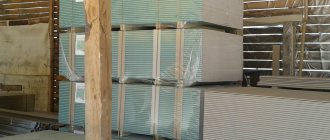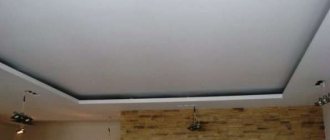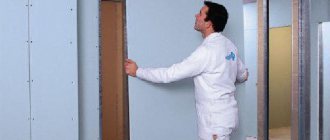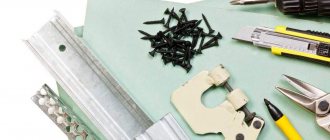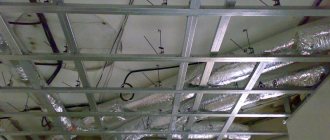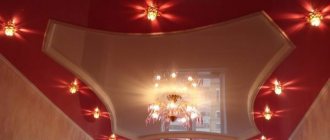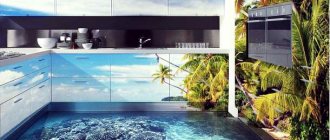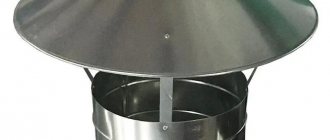Hello everyone, friends! Recently I was faced with such an unpleasant situation: neighbors flooded my parents’ apartment. Need I say what the plasterboard with which the ceiling was covered turned into? In this regard, I decided to install a new structure and use a different material. After all, gypsum fiber board for the ceiling (as gypsum fiber is called) is noticeably more reliable. Despite some shortcomings, when flooded they stand like a monolith! True, working with the material is more difficult due to the fact that it does not bend, and the weight is noticeably greater. Let's together understand all the properties of gypsum fiber boards and study the technology for installing ceilings.
Differences between GVL and GCR: advantages of the option
What is drywall? These are two layers of special cardboard, between which a gypsum shell is tightly contained. Gypsum fiber does not have any shell. The gypsum fiber panel has an absolutely homogeneous structure. This gives GVL significant advantages over GCR.
- Density _ This parameter is very important when you are going to finish the ceiling in an apartment with your own hands. In this case, the density of gypsum fiber finishing will be twice as high as that of plasterboard finishing.
- Temperature resistance . GVL is resistant to any temperature conditions. Even if the temperature in the apartment drops below zero, the gypsum fiber ceiling will not be damaged.
- Noise absorption . This parameter is slightly higher than that of drywall, although not by much.
- Fire resistance . GVL has a high fire resistance.
- Durability . As mentioned earlier, gypsum fiber has a high density, which gives it a significant advantage in strength. A screw screwed into such a panel can support thirty kilograms of weight.
- Moisture resistance . The versatility of this material concerns not only temperature conditions, but also air humidity. GVL panels can be installed both in rooms and in the bathroom, while to install gypsum boards you will have to purchase special moisture-resistant green sheets of plasterboard.
- Thermal insulation . This material is very good at retaining heat in the room.
- Perfectly flat surface . If you plan to paint the walls after finishing or hang wallpaper, then gypsum fiber will create the necessary, even surface and the walls will look perfectly smooth. Although this is not always necessary, since gypsum fiber boards, unlike gypsum plasterboards, look quite good even without secondary finishing.
- Environmental friendliness . Gypsum fiber is a natural and environmentally friendly material. GVL panels consist of almost one hundred percent natural materials, which helps create a favorable indoor microclimate, which is very important for the health of apartment residents.
The main advantage of GVL is resistance to humidity, temperature and fire resistance, as well as great strength!
Disadvantages of using gypsum fiber board for ceilings and walls
This material is not without its disadvantages:
- Treatment . Because gypsum fiber panels are much stronger and denser, they are much more difficult to cut, so if you need to shape the panel into a curved shape, you will encounter difficulties that would not arise with drywall.
- Weight . Gypsum fiber panels are significantly heavier than drywall.
- Flexibility . GLV panels are much more difficult to bend, which can greatly affect the design of the ceiling.
- Price . Gypsum fiber, for any type of construction, will cost more than plasterboard.
The main disadvantages of GVL are its heavy weight and difficulties in processing.
Relevance of using gypsum boards
The material is used to create partitions, various structures, and wall cladding. GCR is easy to install, so you can implement various ideas in terms of interior design, achieve cosmetic cleanliness in your living space, and also implement original construction and finishing ideas even on your own.
Thanks to sheets of drywall, owners can easily:
- eliminate uneven surfaces in the apartment, hide corners or curved walls;
- make a redevelopment by installing partitions;
- create exquisite design structures in the form of arches, niches, columns;
- complement the room with built-in lighting.
Installation of GVL on the ceiling: what you need to know
You don’t have to spend a long time preparing the surface for laying gypsum fiber boards. Since this material is mainly intended specifically for leveling walls, it is not sensitive to small irregularities, so you only need to level the wall if there are very serious flaws. The main thing is to clean the ceiling. If mold, rust or other types of contaminants have accumulated on it, they must be removed before proceeding with the installation of gypsum fiber board panels.
Also, you will have to get rid of the old finish, but this only applies to those cases when slabs or panels are already installed on the ceiling. Materials such as paint or wallpaper will not interfere with the new finish.
Many people who live in cold regions or simply love warmth prefer to insulate the ceiling before finishing. For this purpose, special insulating boards are installed, which not only increase the average temperature in the room, but also improve sound insulation in the house.
GVL ceiling frame
Once you have prepared the ceiling for finishing, you can begin to create the frame that is necessary to hold the gypsum fiber panels to the ceiling. Unlike plasterboard, gypsum plasterboard panels cannot be easily fixed to the ceiling due to the weight of the structure. Therefore, the first thing that needs to be done is marking the ceiling.
There are several options with which you can make a frame for installing a suspended ceiling from gypsum fiber. The first is the installation of metal profiles on the ceiling. This design is universal and is suitable for both dry and wet rooms. This is a definite plus, especially if you want to finish the ceilings throughout the apartment.
Installation of a frame for a GVL ceiling
However, this is too expensive a method. It is expensive both in terms of funds and labor intensity. Therefore, if you want to carry out repairs quickly, easily and cheaply, then the second method is more suitable for you.
The second method is to install wooden sheathing. The sheathing is created exclusively from wooden blocks.
Installation of wooden lathing for gypsum fiber boards
This type of frame is considered quite good and, at the same time, less expensive than metal. However, it loses greatly in versatility, since it is only suitable for dry rooms with a constant air temperature in the room. Under the influence of moisture or temperature changes, a wooden frame can change its shape, rot and deform, which ultimately leads to deformation of the entire ceiling. Therefore, when finishing the ceilings throughout the apartment, it is better not to use wooden blocks to create a frame in all rooms.
Once you have decided on the choice of material, you can proceed directly to marking the ceiling, and then begin installing the frame.
Video description
How to fix drywall without profiles.
For wooden ceiling
Wood is a mobile material. When installing without a frame, there is a risk of cracking of natural raw materials. During installation, it is important to select self-tapping screws of the appropriate length with a small margin. The bolts are carefully screwed in, and not pressed into the construction and finishing sheet, trying not to recess the caps.
The ceiling in a house made of wood often has protruding crossbars and a top board made of boards. Drywall is screwed to such a surface with self-tapping screws to the beams and in the spaces between structures. Construction and finishing sheets are tightly joined.
Working with natural coating Source lifehacker.org.ua
If the ceiling is wooden with rough boards, then installation is carried out along the surface of the coating. Special wood fasteners must penetrate the gypsum board and reach the base. To prevent screws from being pressed into a soft sheet, washers are used.
Area above the head made of plaster Source velum.com.ua
Laying a GVL ceiling
In principle, the technology for laying a ceiling using gypsum fiber panels is no different from similar processes using plasterboard. However, some significant differences still exist and need to be considered separately.
The first problem that confronts us is the heaviness of the panel. It is too heavy to be lifted and installed alone, so it is best to get a partner or hire workers. But you can do it alone. To do this, you will need one or two telescopic stands. They will make it easy to lift the slabs and fix them close enough to the ceiling so that further installation will be more difficult for you. Once the sheets are fixed at a sufficient height, you can begin screwing them to the frame.
Do not attempt to install gypsum fiber board on the ceiling alone. It weighs too much.
To secure the gypsum fiber to the frame, use regular self-tapping screws. They will securely secure the structure. The sheet must be secured with self-tapping screws to each profile. There should be a clear gap between the screws, approximately fifteen to thirty centimeters. Do not attach screws too close or too far from the edge of the gypsum fiber board. The distance from the edge of the panel should be one centimeter. This is necessary to maintain the integrity of the edges of the gypsum fiber sheet.
After connecting the first sheet to the frame, you can begin installing the second plate. It needs to be secured in the same way as the first one. However, first, you need to lubricate the end with special glue in those places where the two sheets will touch in the finished structure. Only after completing this procedure can the next slab be installed. Each subsequent slab must be connected in the same way.
Surface cladding
At this stage, for the first time we will have to face some differences in the principles of assembly. The gypsum fiber components of the coating are not simply screwed to the frame with self-tapping screws, but also require gluing the ends of the elements with a special glue when connecting.
The cutting of parts is also carried out differently - more “serious” tools are needed, since the density of the material will not allow cutting it with an ordinary stationery knife. A circular saw or jigsaw is better suited here. When cutting, a large amount of gypsum dust appears, therefore, care should be taken to protect the respiratory system with a special maxi respirator.
Otherwise, the assembly of the structure occurs in exactly the same way as structures made from standard gypsum sheets. You just need to take into account the greater weight of the elements and use the help of another person, or use lifting mechanisms like telescopic stands, which will allow you to lift heavy fragments of the coating to the ceiling.
How to cut gypsum fiber board sheets
During installation work, you will have to cut the gypsum fiber board more than once. This is not an easy task. For cutting, it is best to use a jigsaw or grinder. Please note that sawing gypsum fiber is fraught with a lot of dust. Once you have marked the cutting line, use a flat surface as a support and cut the panel.
After you have installed all the panels, you can begin the final part of the work. First of all, all joints between the plates must be treated with gypsum putty, and reinforcing tape must be glued on top of the seams.
When installing gypsum fiber boards, do not forget to treat the joints
Then you need to seal the holes from the screws. Apply a small amount of the same putty to the depressions and smooth them out. At this point, the installation is complete, but if desired, you can give the ceiling a perfect evenness using putty.
Gypsum fiber is a relatively new, but already very popular, material for finishing premises. It is produced in the form of sheets, the characteristics of which are similar to plasterboard slabs, but superior to them in many respects. The composition of gypsum fiber sheet (GVL) includes building gypsum, reinforced with dissolved cellulose, which is “extracted” from ordinary waste paper. Today this material is less known than its older brother - drywall, since it costs slightly more than its counterpart.
Base assembly
For installation, you can use the same profiles that go on the bases for gypsum boards. There will be no difference in this part of the work - the base is assembled according to exactly the same principles as for drywall. The only point that should be given more attention is the strength of the frame.
Gypsum fiber finishing has more weight than conventional gypsum sheets and therefore, the structural strength in this case should be greater. No special additions to the standard frame are required; you just need to carefully monitor the adhesion strength of the hangers to the ceiling and walls.
Features of gypsum fiber sheets
Gypsum fiber has a number of unique characteristics that are unavailable to most building and finishing materials:
- Easy installation. Carrying out repair and finishing work using gypsum fiber eliminates the use of labor-intensive “wet” technologies.
- Structure. Unlike drywall, gypsum fiber sheets (plates) have a homogeneous structure with no outer shell. This advantage is due to the increased strength of gypsum fiber and its ability to withstand maximum load.
- Environmental Safety. Gypsum fiber is an environmentally friendly product; its level of natural radiation is 3 times lower than that of brick.
- Frost resistance. The material can withstand 15 freeze-thaw cycles, while drywall begins to crumble and crack after 4. Thus, GVL sheets can be used in finishing unheated rooms (attics, basements, garages).
- Soundproofing. Gypsum fiber perfectly insulates the room from extraneous noise. Its sound insulation performance can reach 35 dB.
- Moisture resistance. The use of gypsum fiber boards in rooms with high levels of humidity (bathrooms, kitchens) involves the use of their special type, which has increased moisture resistance - GVLV.
- Resistant to open fire. Due to the absolute non-flammability of the material, installation of GVL is recommended for premises with special fire safety requirements.
Disadvantages of gypsum fiber ceilings
A jigsaw or hand-held circular saw is best for cutting sheet metal.
The weight of gypsum fiber is much heavier than that of the same drywall, so it creates additional load on the floors. But the load exerted is not so significant as to refuse to use GVL.
Before installation, you just need to make sure that the base base of the ceiling is strong and reliable. The cost of the material is quite high, especially if you buy fire-resistant (GVLO) or moisture-resistant (GVLV) types. Labor intensity. There are 2 aspects that complicate working with gypsum fiber:
- GVL, in comparison with plasterboard, is much more difficult to process, it is difficult to bend, and, accordingly, it is very difficult to arrange curved surfaces;
- installing a structure with your own hands is very difficult, since gypsum fiber boards have significant weight.
Results.
After analyzing all of the above and comparing which is better: gypsum fiber or plasterboard, it is impossible to answer unequivocally.
It all depends on the room in which the materials will be attached, operating conditions and design solutions related to the ceiling.
Application of GVL for finishing ceilings, floors and walls
Gypsum fiber boards can be used for cladding walls or floors, arranging suspended ceilings, interior partitions, creating decorative structures and sound-absorbing screens. Gypsum fiber sheets can also serve as a fire retardant coating for rooms with normal humidity conditions.
Along with the use of GVL slabs for finishing walls and ceilings, this material is often used when installing dry floor screed. Any finishing coating can be laid on top of it - durable gypsum fiber will provide an absolutely flat, reliable surface. To carry out such work, it is not at all necessary to hire professionals; the sheets can be laid independently and very quickly.
Preparatory operations
In fact, when installing such suspended compositions, there is no special need to prepare the floor. It is enough just to clean all the areas where the old coating is coming away from the floor slab or other base.
If preparation is not required, all that remains is to carry out marking work and you can begin assembling the frame. Correct marking is very important for creating a beautiful and durable structure, so you should pay enough attention to this stage of work.
GVL installation options
The installation of gypsum fiber boards, although they do not require the use of special skills, must be carried out strictly in stages; it is the observance of a certain procedure that will ensure the required operational characteristics of the structure. Surface finishing can begin only after all preparatory work has been carried out, including cleaning, leveling, eliminating defects and priming.
Installation of gypsum fiber boards for walls, floors or ceilings has its own characteristics. For example, laying a dry screed will significantly raise the floor level, which will require sawing down the doorway. If we are going to lay the slabs directly on a wooden floor, we must securely fasten its elements and remove all rotten parts.
The first method of installation work is as follows: you need to lay sheets of gypsum fiber on a special glue, using self-tapping screws for gypsum fiber board as fasteners. We fasten the slabs around the perimeter, following the following technology: material thickness – up to 12.5 mm, length of self-tapping screws – 40 mm, pitch – 400 mm. The screw caps must be recessed 1.5-2.5 mm deep.
Frame installation method
The second installation option is the frame method. To perform this type of work, only the most common tools and materials are needed:
- plumb line, level, tapping cord;
- drill, grinder, screwdriver;
- dowels, self-tapping screws for gypsum fiber board and metal.
The lathing of the structure can be made of wooden beams, but the best material for its manufacture is considered to be a galvanized metal profile - it is more reliable and durable. The frame must be assembled in such a way that its elements are located at a distance of no more than 400 mm from each other.
When carrying out installation work, many novice craftsmen ask the question: what is the best way to cut gypsum plasterboard? There are several options for solving this problem, it all depends on your capabilities and preferences. Some craftsmen recommend cutting the sheet with a knife, others use a circular saw or grinder. We believe that the best way out of this situation is to use a jigsaw with a built-in vacuum cleaner - its operation eliminates the formation of large amounts of dust.
It is important to remember that when using the first (frameless) method of surface cladding, it is necessary to maintain a certain width of the gap between the plates (6-8 mm), seal the joints with a special gypsum putty and use a special glue for gypsum plasterboard.
Preparation of sheets and base
First of all, the old finish is removed, then the rough base of the base ceiling is cleaned and treated with antiseptic substances. Level the ceiling only if there are significant unevennesses. Seal deep cracks and large chips.
Ceiling covered with gypsum fiber board
Sound-absorbing, heat-insulating slabs made of mineral wool or any other material are laid. For damp rooms or buildings with an unreliable roof, lay a waterproofing film and treat the surfaces with a hydrophobic sealant.
It is better to cut gypsum fiber board using an electric jigsaw for wood or use a hacksaw. Work is carried out in a respirator due to the formation of large amounts of dust. To increase resistance to spraying, latex impregnation treatment is used. The edge is processed with a plane.
Before installing the slabs on the ceiling, they determine the technical sleeves for utilities, think through the scenario of the main lighting and lighting in the interior.
GVL finishing
Any type of wallpaper, paint or tiles can be used as materials for finishing the coating. Let's talk about tiled cladding. First, you need to determine a step-by-step scheme for performing installation work. It should consist of surface treatment and marking, preparation of tiles and adhesive, laying itself, as well as subsequent grouting.
- Before laying tiles on gypsum fiber boards, it is necessary to treat the sheets with a special primer and wait for it to dry.
- It is necessary to determine the required amount of tiles based on the length and width of the surface to be finished. Knowing the size of the products, taking into account the width of the seams, you can calculate their total number.
- Now you should apply the adhesive composition to the surface, distributing it in an even layer using a spatula.
- When laying tiles on GVL, it is necessary to lightly press them down to increase the reliability of fastening. Many experts advise using a rubber mallet for this purpose.
- You should leave equal gaps between the tiles, carefully cleaning them from the adhesive mass. After a day (when tiling walls) or 48 hours (for floors), the seams between the tiles must be grouted using special compounds. All this time, the room must maintain a minimum level of humidity.
A very important role in the cladding of gypsum fiber sheets is played by the correct selection of primer and adhesive composition - the quality of fixing the tiles will depend on them.
Material from KNAUF
The well-known manufacturer of gypsum fiber boards, the KNAUF company, recommends using only high-quality materials for finishing during installation and consistently performing all stages of the technological process. German experts advise using a special branded FLIESEN tile adhesive in your work, preparing it in small portions, sufficient to treat a surface area of 1 m2.
That's all, let's hope that our article will help the novice home craftsman decide on the finishing option for his favorite room. If an experienced craftsman honors us with his attention, we will ask him to share his experience and tell us how best to cut gypsum fiber board, how to finish it, and most importantly, how to avoid mistakes during installation.
